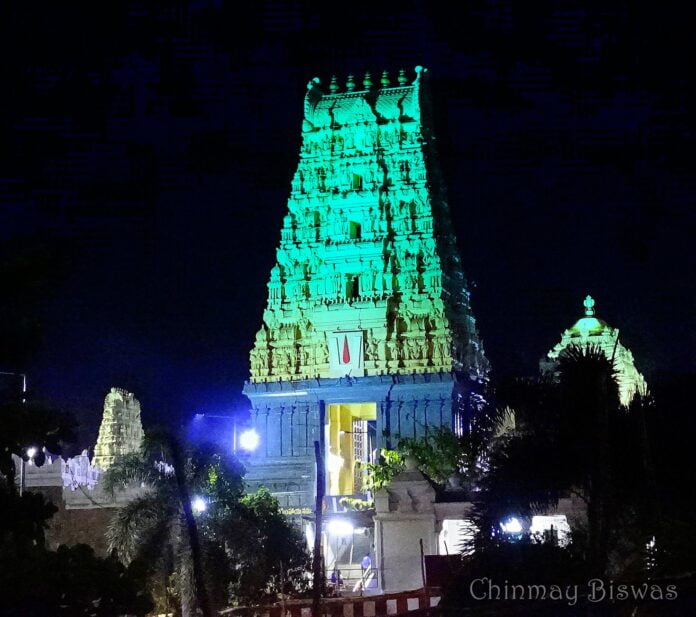Simhachalam Temple, located in the Indian state of Andhra Pradesh, is a popular Hindu temple dedicated to Lord Narasimha, an incarnation of Lord Vishnu. The temple is one of the most visited and revered pilgrimage sites in the region, attracting thousands of devotees every year.
The name “Simhachalam” comes from the Sanskrit words “simha” meaning lion and “achalam” meaning hill.
The temple is situated on top of a hill, which is believed to resemble a lion, hence the name. The temple is believed to have been built during the 11th century by the Eastern Ganga Dynasty rulers.
The main deity of the Simhachalam Temple is Lord Narasimha, who is depicted as half-man and half-lion.
Simhachalam Temple is not only a religious site but also a popular tourist destination. The temple’s location on top of a hill provides a panoramic view of the surrounding area. The temple’s architecture and carvings are also a sight to behold and attract many visitors.
History of Simhachalam Temple
The exact age of the temple is not known, but it contains an inscription, dated as far back as 1098-99 A.D. of the Chola king Kulottunga-I, who conquered the Kalinga territories, and it must thus have been a place of importance even by that period. Another inscription shows that a queen of the Velanandu chief Gonka III (1137-56)covered the image with gold a third says that the Eastern Ganga king Narasimha.
I built the central shrine,the mukhamandapam,the natyamandapam, and the enclosing verandah in black stone in the later half of 13th century and other grants inscribed on its walls (the Government Epigraphist’s lists for 1899 give not less than 125 such inscriptions) make it a regular repository of the history of the district.
The Simhachalam temple still contains in inscriptions left here by Sri krishna Devaraya of Vijayanagara empire recounting his successes and relating how he and his queen presented the yod with necklace of 991 pearls and other costly gifts.
Architecture of Simhachalam Temple

The idol of the deity is believed to be a self-manifested one, which means it was not sculpted by any human hand. The idol is made of a rare black granite stone and is 10 feet tall, making it one of the largest statues of Lord Narasimha in the world.
The temple has a unique feature in that it has two entrances, one for the upper-class devotees and the other for the lower-class devotees. This is a tradition that has been followed for centuries and is still maintained today.
The temple also has a beautiful architecture with intricate carvings and sculptures that depict scenes from Hindu mythology.
The temple complex also has a large pond called “Varaha Pushkarini,” which is believed to have been created by Lord Varaha, an incarnation of Lord Vishnu.
Festivals Celebrated in the Temple
The Simhachalam Temple is known for its annual festival called “Chandanotsavam” or “Nijaroopa Darshanam,” which is held in the months of April and May.
During this festival, the idol of Lord Narasimha is covered with sandalwood paste, which is believed to have healing properties. This festival is attended by thousands of devotees from all over the country.
Apart from the main temple, there are several other smaller temples within the complex dedicated to various deities such as Lord Shiva, Lord Ganesha, and Goddess Lakshmi.
ALSO READ: ABOUT VENKATESWARA TEMPLE TIRUMALA
Quick Facts
- Address: Simhachalam Rd, Simhachalam, Visakhapatnam, Andhra Pradesh 530028
- Affiliation: Hinduism
- Timings: 06:00 AM – 09:00 PM
- Deity: Varaha Narasimha / Laxmi Nrusingha (Vishnu), Simhavalli thayar(Lakshmi)
- Entry Fee: Free
- Visit Duration: 1 to 2 hours
- Architecture Style: Kalinga architecture; Dravidian Architecture
- Dress Code: decent outfit recommended
- Festivals: Dola Utsava; Kalyanotsava; Chandanotsava; Narasimha Jayanti; Navaratrotsava; Kamadahana
- Best Time to Visit: October To March
Pooja Timings
| 04:00 AM to 04:10 AM | Melkolupu(Naadaswaravadyamu) |
| 04:10 AM to 04:30 AM | Suprabhatha Patanamu |
| 04:30 AM to 04:45 AM | Suprabhatha Darshanamulu |
| 04:45 AM to 05:00 AM | Antharalaya Sammarjanamu |
| 05:00 AM to 06:30 AM | Prathararadhanamu |
| 05:30 AM to 09:30 AM | Veda Itihasa Puranamula Parayanamu |
| 05:30 AM to 06:30 AM | Aaradhana Ticket Darshanamu |
| 06:30 AM to 11:30 AM | Sarvadarshanamulu |
| From 9:30 AM | Sri Swamy Vari Nithya Kalyanam |
| 11:30 AM to 12:00 PM | Mahanivedanamu (Rajabhogamu) Darshanams Break |
| 12:00 PM to 02:30 PM | Sarvadarshanamulu |
| 02:30 PM to 03:00 PM | Madhyana Viramamu (Pavalimpu Seva) Darshanams Break |
| 03:00 PM to 07:00 PM | Sarvadarshanamulu |
| 05:00 PM to 08:00 PM | Veda Parayanamu |
| 07:00 PM to 08:30 PM | Ratri Aaradhanamu |
| 07:30 PM to 08:30 PM | Aaradhana Ticket Darshanamu |
| 08:30 PM to 09:00 PM | Sarvadarshanamulu |
| After 09:00 PM | Eekanta Seva, Kavaata Bandhanamu |
How to reach Simhachalam Temple?
By Air
The nearest airport to reach Simhachalam is Vishakhapatnam which is about . it takes one hour to reach Simhachalam from Visakhapatnam.
By Rail
There are many train facilities from New Delhi, Mumbai, Calcutta, Hyderabad, Bangalore, Chennai, and Bhubaneswar. The main railway station is Vishakhapatnam railway Station
By Road
Many cabs are available in Visakhapatnam to serve from Visakhapatnam to Simhachalam, and the ticket fares will depend on the type of the vehicle.
If you like our work then please Donate to us so that we can keep posting content regularly.
Note: We don’t make any guarantees if the above-stated facts are not correct. If you think any information provided by us is wrong then contact us.

I?ll right away grab your points